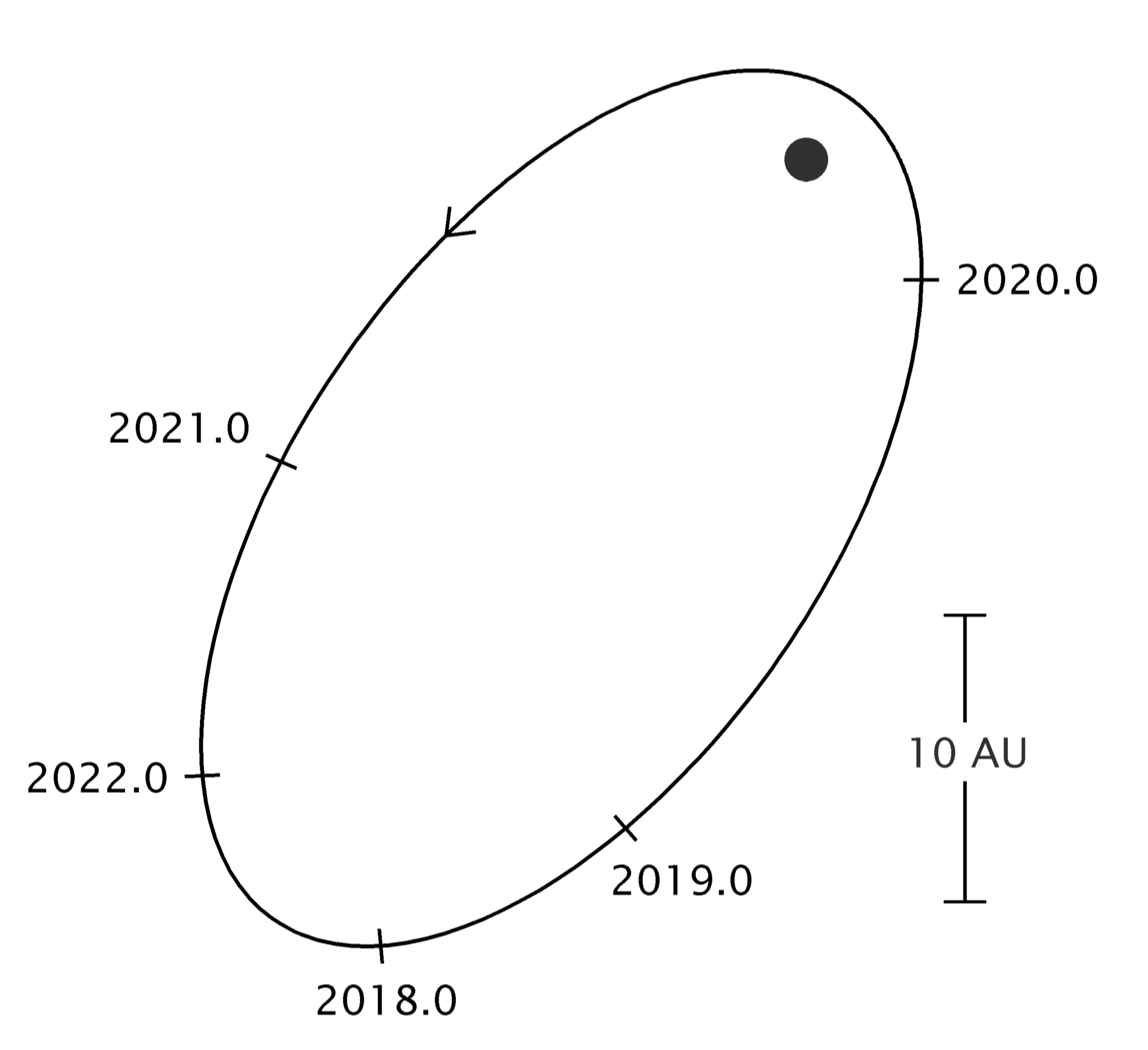Eta's Companion Star
Eta Carinae has a secondary star in a 5.5-year orbit. Most likely this companion has a mass around 50 M⊙ and a luminosity (power output) of the order of 500,000 L⊙; but it can't be observed directly so we have to rely on indirect clues.
These numbers are extraordinary; compared to stars in general, Eta Car's companion is as unusual as a human who is 2.5 m (8 feet) tall. If it were isolated in space it would be easy to observe, and astronomers would consider it famous. But it's hidden by the glare of the main star! Eta Car is arguably the most remarkable binary star system in all of known astronomy, with a broader assortment of phenomena than any other known pair.
Discovery of the Second Star
This object was recognized in stages. Before 1990 a few people speculated that Eta Car might be a binary []. Independent of them, Zanella et al. suggested a 17-year periodicity because temporary spectroscopic changes had been seen in 1948, 1965, and 1981 []. After 1990, Whitelock et al. found a 5-or-6-year brightness variation and then Damineli found a spectroscopic period of 5.5 years [, ]. Because earlier observers had failed to notice events in 1953, 1959, 1970, and 1975, Zanella's 17-year period turned out to represent three full cycles.
The researchers mentioned above originally interpreted 5.5 years as a single-star pulsation period, not an orbit. Then, in 1997, M.F. Corcoran et al. noted possible binary characteristics in the X-ray behavior, while Damineli et al. measured Doppler velocity variations reminiscent of a binary star orbit [,,]. Their orbit model was unsatisfactory, but an improved version seemed credible []. All of those observations referred to the primary star or to the two colliding stellar winds, not the smaller companion star itself. Later developments supported the binary hypothesis.
The orbit

The orbit of Eta Car's companion star, an approximate plan view. Most researchers believe that we view it from below the lower edge of this figure, except that the orbit plane is tilted about 45 degrees from our line of sight.
Given Eta's likely mass range, a 5.5-year orbital period implies a semimajor axis of 16 to 19 AU, i.e., the orbit is comparable in size to that of Uranus going around the Sun. Since two stars that far apart cannot significantly affect each other, we need to imagine a highly eccentric orbit, so they approach each other closer than 4 AU once every 5.5 years -- as shown in Figure 1. (The closest approach in a binary star system is called "periastron," and 4 AU is about 600 million km.)
We view Eta Car from below the lower edge of Figure 1, at an angle of about 45 degrees from its plane. The eccentricity of the ellipse is probably between 0.8 and 0.9; the diagram assumes 0.85. For the reasoning behind these statements, see [], ], and other references cited there.
Because Eta Car is 7500 lightyears away, this orbit is too small to resolve even with the Hubble Space Telescope. Its projected diameter is only about 0.01 second of arc.
Parameters of the Companion
Mehner et al. [M10] analyzed our main clues to the nature of the secondary star:
- X-ray data show that its stellar wind has a speed of 3000 km/s. Only very hot stars have winds that fast.
- It must produce enough extreme ultraviolet (EUV) radiation to ionize nearby helium, which is seen in the spectrum; the primary isn't hot enough to do that.
- It must be around 2 million years old, or anyway more than 1 million years. This statement is based on the evolution state of the unstable primary star.
Together, these conditions indicate limits on the star's parameters:
- Luminosity: between 100,000 and 1,000,000 L⊙, and most likely about 500,000 L⊙.
- Surface temperature: between 36,000 and 45,000 K, most likely about 40,000 K which is twice as hot as the primary star and 7 times as hot as the Sun.
- Mass: between 30 and 70 M⊙, most likely about 50 M⊙. This is somewhat less than half the mass of the primary star.
As noted earlier, these values are very impressive, one of the most massive stars known in this part of the Galaxy. But we can't observe it directly, for two reasons: First, the primary star is almost ten times more luminous, in terms of total output. Second and more important, the secondary star's high temperature means that it radiates most of its luminosity at extreme ultraviolet (EUV) wavelengths. We can't observe those EUV photons, because they're absorbed by interstellar gas. The primary star, by contrast, has a dense wind that radiates mainly at near-ultraviolet and visual wavelengths, which can be observed fairly well.
Symbols
- AU: In these notes "AU" is a unit of distance, the Astronomical Unit. It's equal to the average distance of Earth from the Sun, about 150 million kilometers. M⊙ and L⊙ mean the mass and luminosity of the Sun.
- M⊙: Solar Mass
- L⊙: Solar Luminosity
